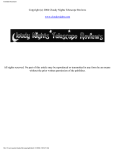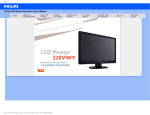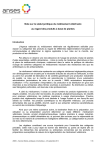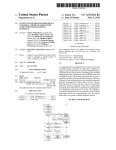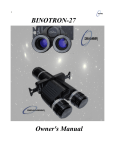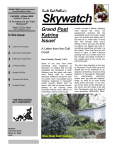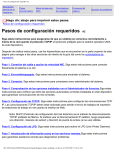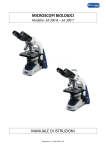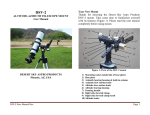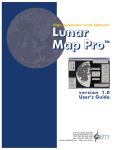Download BC&F Astro Engineering Binoviewer
Transcript
Untitled Document Copyright (c) 2004 Cloudy Nights Telescope Reivews Copyright (c) 2004 Cloudy Nights Telescope Reviews www.cloudynights.com All rights reserved. No part of this article may be reproduced or transmitted in any form by an means without the prior written permission of the publisher. file:///Users/asaint/cloudy/lab/copyright.htm3/13/2004 2:02:45 AM Copyright (c) 2004 Cloudy Nights Telescope Reivews BC&F Astro Engineering Bino Mate By Jim Gutman mailto:([email protected]) Knowing that I’ve extensively tested most of the binoviewers on the market along with their accessories, Allister asked me to take a look at the BC&F Bino Mate binoviewer and see what I thought. I had heard a few things about the unit in various places on the Internet, but as is normal with new products, little definitive information. The package arrived and I opened it up to check it out. It came in a very nice foam lined plastic case with the company’s logo emblazoned on the front. Inside, I found the binoviewer and a pair of eyeguards. The foam is already cutout with room for 4 other components. Copyright (c) 2004 Cloudy Nights Telescope Reivews First impressions: It’s a very small unit (17.5 ounces). It didn’t come with any compensator lenses. It used tiny setscrews to hold the eyepieces. It had individual focusers on both sides. The casings are made of plastic. Copyright (c) 2004 Cloudy Nights Telescope Reivews Rather than judging the unit by my usual criteria, I decided to spend some time on the websites of the manufacturer and the distributor. I wanted to understand what market they were targeting. Then, I could assess its capabilities based on who would be the potential buyer for this unit. You’re probably wondering what’s my usual criteria? How does it work in every kind of telescope, for both high powered (planetary, lunar, solar, double star) viewing and for medium and low power DSO observing. We generally check out a binoviewer in short focal length refractors, SCTs, and large 20”+ Dobs. I went to the site of the US Distributor (www.digitalastronomy.com) and read the marketing materials as well as the user manual. Then, I visited the website for BC&F Astro Engineering (www.astro-engineering.com). Much to my surprise, the product was not yet listed on their web site. The American distributor says that they are the first to have it available for customers. The website says that BC&F Astro Engineering is the manufacturing division and product brand name of Broadhurst Clarkson and Fuller Limited of Tunbridge Wells England. It also says “BC&F Innovative British-Made Astronomical Accessories”. That would suggest that their products are made in Great Britain. Further exploration found the product on the website of Telescope House (www.telescopehouse.co.uk). I read through all of their information as well and came to some conclusions about where this product fits in the marketplace. I’ll explain that after I go through the technical details. Specifications Design Weight Clear aperture Interpupillary adjustment Optical Path Length Supplied Compensator Eyepiece Holders Seidentopf (folding binocular style) 17.5 ounces 17mm 56-75mm 102mm None Individual diopter adjustments with setscrews Physical performance The Bino Mate wins the prize as the lightest binoviewer I’ve ever used. Stay with light weight eyepieces and no problems occur in balancing a telescope. The small refractor I use is a Tele Vue TV76, mounted on a Celestron NS114 mount. With the Bino Mate in place and a pair of Orthos or Ultimas, the scope didn’t have any trouble hitting its GOTO targets or tracking them once it found them. I didn’t hear any sign of strain on the altitude motor wherever it was pointed. Each eyepiece holder is equipped with a diopter adjustment, and the on-line manual accurately describes how to use them to reach sharp focus with both eyes. Since it’s Copyright (c) 2004 Cloudy Nights Telescope Reivews warm in Arizona, I put them in the refrigerator overnight to see if they would stiffen when cold. They seemed to work just fine when cold. It also remained easy to adjust the interpupillary distance. I did not, however, subject them to the freezer. The eyepiece holders are equipped with tiny setscrews to hold the eyepieces. I’m not a big fan of using setscrews, as I have felt from observing other people using binoviewers that the clamping of the eyepieces makes it more difficult to merge a pair of high powered eyepieces. The screws are very small, similar in size to a standard 1.25” Barlow. This could make them difficult to use with gloves. Without gloves, they were no problem. The barrels are sufficiently sized to handle all of the eyepieces I tried (Radians, Panoptics, Orthos, and even the 35mm Ultima which has the biggest barrel). I would recommend staying with eyepiece barrels that don’t have an undercut, as the screws are positioned to hit exactly on the top edge of the undercuts on most eyepieces. You will leave a lot of marks on this kind of eyepiece. Looking through the unit without eyepieces or a telescope revealed that the image circles weren’t quite round. The left side of both sides was a straight line. Indicative that the housing and baffling that was used were slightly undersized for the prisms.. I’ve seen several other brands of binoviewers where, if I removed the nosepiece, the image wasn’t round. This was the first one I’ve seen where the image was slightly clipped when it was fully configured with the nosepiece in place. This was also visible when the Bino Mate was used with eyepieces and a telescope, but only if the eyepieces had a field stop larger than about 17.1mm. Putting the full moon into the field of view with 30mm Ultimas clearly demonstrated that the left side was clipped. With the Bino Mate fully opened, the clipping is exactly at 9:00. As they are folded, the clipping point moves upward, reaching a position of about 10:30 on a clock face when they are fully compressed. Without eyepieces, I also noted more reflections than I’ve seen with other binoviewers. Further indication that the prisms aren’t sufficiently baffled. As noted in the specifications, the Bino Mate is a Seidentopf design binoviewer. That means it folds like a pair of binoculars. Advantage to this style of binoviewer is that no refocusing is needed when the interpupillary distance is changed. It is a straight-through design, and gives the same view you would have with a single eyepiece. With a diagonal, it would be correct up and down, reversed left to right. The range of separation is pretty standard for most binoviewers with a minimum of 56mm and a maximum of 75mm. The nosepiece of the unit has standard filter threads. Overall fit and finish were excellent. The extensive use of plastic keeps the weight down, but the unit gave the impression of quality. Other manufacturers who use plastic extensively in various products could take a lesson from BC&F in how the plastic should look and feel. It has the same kind of solid look and feel that the new Canon Digital Rebel camera possesses. The black inserts for grips are made from a little softer plastic than the rest of the unit and lots of little airholes are drilled into them. Makes them quite comfortable and easy to grip. Optical Performance Copyright (c) 2004 Cloudy Nights Telescope Reivews The first optical test I performed was to check the quality of the collimation of the unit using a bright Star (Sirius) and Jupiter. I found the collimation to be perfect vertically, but slightly off horizontally. The left side image was slightly further to the right. It was off by about half the diameter of Jupiter at 175X. It was absolutely no problem to merge the images. Next check was to determine the clear aperture of the unit. The observed performance with different eyepieces confirmed the measurement of 17mm of clear aperture. I could use Plossls up to 20mm. The 15mm Panoptics were OK (same field stop size as a 20mm Plossl – 17.1mm), but the 19mm Panoptics had dark circles around the edge of the view. 24mm and above Plossls, as well as 24mm Panoptics showed a quite severe darkening at the edges. Some of the reports I had seen on the Internet indicated that these binoviewers were very dark, and having a problem with light throughput. I think those reports are not completely accurate. The Bino Mate provided nice bright images as long as I didn’t use eyepieces that exceeded its clear aperture restriction. Everything up to the 20mm Plossls produced nice bright views that seemed even from side to side. Looking through them in daylight with a Barlow lens gave me the impression of a darkened image. So, I tried several other larger clear aperture binoviewers with the same Barlow in front of them, and I didn’t think the Bino Mates were any darker than the other models. I then set up the TV76 to check out the optical path length of the unit. I did tests both in daylight with targets 60 feet away and at night with targets at infinity. I took off the diagonal to reach focus and used an extension tube to set the baseline with a single eyepiece. Both day and night measurements arrived at an optical path length of 102mm. That’s 10mm shorter than any other unit I’ve tested. Makes it more likely to focus in many types of telescopes, without resorting to a Barlow. It also made for a lesser magnification factor when a Barlow was used. I’ll explain the statistics when I talk about getting them to work in different types of telescopes further down in this article. As far as the issue of tint and / or brightness differences, the Bino Mates did not appear to have any tint differences from one side to the other, but they were slightly brighter on the right side. I’ve done this test on enough binoviewers to know that without eyepieces or a telescope, I’ll see some difference in every unit on the market. Some have slight tint differences. Others have a brightness difference. And, a few units displayed both characteristics. I don’t feel it’s an issue in any of the binoviewers when they are used as intended. Swapping eyepieces, or even turning the unit upside down does not change the impression. With the unit upside down, the left side appears brighter, whether I use both eyes (closing one at a time) or move a single eye from side to side. I used the Bino Mate extensively in both my TV76 and my Nexstar11GPS. In both scopes, certain magnifications would cause extended reflections from off center objects. One example was Jupiter. If Jupiter was at or near the center of the field, the images were just fine. If I put Jupiter close to the field stop, I would sometimes see a slight reflection like a beacon extending across the field of view. It happened with both scopes, but only certain power eyepieces. Not brand specific, rather focal length specific. I’m Copyright (c) 2004 Cloudy Nights Telescope Reivews noting this, but I didn’t think it was a particular problem. For Jupiter and Saturn, I would normally use higher powers than I was using when the reflection occurred. Even at the moderate powers where it did occur, they were fine provided the target was near the center of the eyepiece. I did not observe any issues with ghosts in the field. When slewing the TV76 towards the moon, I did note an issue. While the moon was still outside of the field, suddenly a squared off chunk of it appeared in the right eyepiece. It was a reflection from one of the prism walls. This was my indication that the prisms were slightly too large for the amount of baffling provided. Is this a problem? Only if you were trying to study a DSO just off the edge of the moon. I don’t know about you, but deep sky observing isn’t all that rewarding to me when the moon is shining brightly in the sky. More disconcerting was the idea that something could be superimposed on an image that was outside the field of view. With smaller aperture scopes, I don’t think this would be a problem. With the light gathering power of a scope like my NS11, it’s a real possibility. Getting them to work with different telescopes Refractors Getting a binoviewer to focus in a specific telescope is extremely important. If it doesn’t focus, it is a useless accessory. Refractors are the easiest scopes to use to perform measurements of exactly what it takes to reach focus with a binoviewer. Using a Barlow on the nosepiece required 10mm of in-travel over using the same eyepiece in Cyclops mode. I tried 3 different configurations, and surprisingly, they all resulted in the same measurement along the focuser of the TV76. First configuration was using just the lens from a convertible Barlow from Photon Instruments. This Barlow is similar in configuration to the Meade 140 Barlow. Second was using the Barlow with its normal tube. Third was using a Celestron Ultima Barlow. While the distance from the Barlow lens to the eyepiece was changed a little with each configuration, the distance from the Barlow lens to the telescope’s objective was the same. While the focuser position didn’t change, the magnification factors did change, depending on which configuration I used. Using just the Barlow lens resulted in 3.2X magnification over a single eyepiece view, and using the full Photon Barlow assembly resulted in a 3.9X increase in magnification. In case you are wondering, removing the diagonal and using the binoviewer straight through does not result in any magnification increase from the binoviewer itself. If you can create a configuration that doesn’t require a Barlow lens, you have the same power as a Cyclops view in a refractor or a reflector. Catadioptrics are a different story. Catadioptrics The Bino Mate should come to focus with any Catadioptric telescope that has 102mm (4 inches) of available back focus (in-travel). It will work fine with eyepieces up to 20mm Copyright (c) 2004 Cloudy Nights Telescope Reivews Plossls (50 degree apparent field of view). Depending on the focal length of your particular scope, this may or may not be low powered viewing for DSOs. Because of the way a Catadioptric telescope moves the primary closer to the secondary, any change in focal position results in either an increase or decrease in the magnification being provided. Since we are generally adding to the optical path, an increase in magnification can be expected. It’s difficult to put a precise number on this magnification, as it will vary with the aperture and focal length of the specific scope. For the NS11, it appeared to be providing about 108% of a single eye image when used without a Barlow. Reflectors Most likely you will need to use a Barlow lens to reach focus. If you have 4” of in-travel available, then they will reach focus without a Barlow. As far as the exact focus travel requirements with a barlow, see the notes above about refractors for precise measurements. Solar Observing I set up my TV76 with the SolarMax40 to assess the performance of the Bino Mate as a solar observing accessory. I did successfully get it to work, but there are some definite rules about the Coronado products that need to be documented. The Solarmax and Maxscope products come with blocking filters designed to handle telescopes within certain focal lengths. A BF5 will do up to 500mm, a BF10 up to 1000mm, a BF15 up to 1500mm, and a BF30 will handle up to 3000mm focal length. Because you must add a Barlow lens to the Bino Mate, you are effectively increasing its focal length. If you have the Solarmax on a short refractor with a focal length of 500mm or less, you can get away with the BF5 for single eye viewing. Adding a binoviewer and Barlow will require a BF10. Likewise, if your scope is around 1000mm focal length, adding a Barlow and binoviewer will require at least a BF15, and possibly a BF30. Increasing the requirement for the blocking filter causes a significant change in the pricing for a solar setup. The difference between a BF5 and a BF10 is $185. The BF15 costs an additional $275 over the BF10, and the BF30 is another $1,000 over the BF10. The standard Maxscope40 comes with a BF5. I would certainly recommend changing the BF5 for a BF10 at the time of purchase if you have any thoughts of using a binoviewer with the unit. The Coronado PST is designed as a sealed unit, and can not be used with a binoviewer. Copyright (c) 2004 Cloudy Nights Telescope Reivews My setup includes the Solarmax40 and a BF10. The TV76 has a focal length of 480mm. I am able to successfully use the Bino Mate with a Barlow between the binoviewer and the Coronado diagonal, but I can not use the Barlow on the nose of the diagonal. Target Market It was apparent from the marketing pieces that this unit was never intended to compete with the high end of the binoviewer market. It is intended as a solution for owners of smaller scopes. For scopes like the Meade ETX series, or the Nexstar4/5 from Celestron, they are a viable choice. With their significantly lighter weight, balance issues will be orders of magnitude less than with the larger, heavier units. For a small refractor on a small mount, they have the same advantage of weight. Because of the much shorter optical path, a typical Barlow lens does not cause the same kind of magnification that it does on the binoviewers with larger, longer paths. Two notes from the marketing pieces 1. The Bino Mate can be made to work with most any kind of telescope 2. The Bino Mate is useful for lunar and planetary observation While I’ll agree with the statements as written, I would add that it could be useful for deep sky viewing of certain objects, where one generally uses higher magnification (globular clusters, planetary nebulae, smaller galaxies and double stars). While it will also work with larger scopes, you will be limited to higher powered views, whether because of the need for a Barlow, or the lower limit of 20mm Plossl eyepieces. Conclusion First, I know you are wondering how they compare in size to other binoviewers on the market. Here’s a picture of the Bino Mate side by side with a Denkmeier II, which is physically the largest of the units I’ve tested. As you can see, the Bino Mate is significantly smaller. Copyright (c) 2004 Cloudy Nights Telescope Reivews I think I have documented every issue a user will encounter with the unit. That still doesn’t answer the question of what did I think of it overall. As an entry level binoviewer, it fills a niche quite nicely. It doesn’t embarrass itself and provides a viable alternative for the owner of a small scope, or the curious who don’t want to spend more to try out a binoviewer. It delivers the usual benefits of binoviewing, including an increase in contrast and the ability to use both eyes. For someone who has a smaller scope (focal length, aperture and mount) it’s worth serious consideration as a way to enter the field of two eyed viewing. Since most people who own a telescope already have a Barlow lens, not adding a compensator keeps the price down. Even an owner of a larger telescope can find this product useful, provided they understand that the Bino Mate was designed more for lunar and planetary viewing than it was for deep sky observing. It lacks somewhat in competition to the high end of the market, but it comes at a very different price point. In the US, the price is $329.95. This puts it at the bottom end of the market in terms of price. In England, it’s an entirely different story. Products imported from the US carry a significant price penalty. The importers of most any product generally price a product in the same value as US dollars, but in British Pounds. With the exchange rate currently hovering around $1.80 / 1£, a $600 product in the US priced at 600£ is the equivalent of $1,080. A $1,000 US product ends up at being the equivalent of $1,800! With a price in Britain of 159£, this product is only about ¼ the price of an imported product. A huge difference. This is why many Europeans buy products directly from US distributors or manufacturers when they can. I haven’t seen any pricing yet for anywhere else in the world but, in England it should create quite a market for this newcomer. Copyright (c) 2004 Cloudy Nights Telescope Reivews Three points I want to emphasize. If you attempt to use eyepieces that have a larger field stop than a 20mm Plossl (17.1mm), you will notice the darkening at the outer edges of the eyepieces. And, you will see the clipping on the left side of the images. For most reflectors and refractors, you will need to supply a Barlow lens to permit the Bino Mate to reach focus. This is because of the additional 4” (102mm) of travel required to push the light cone through the binoviewer body. Most catadioptric telescopes will reach focus without an additional lens, but they will cause more magnification than the same eyepiece used in Cyclops mode. Here’s what they look like mounted on my TV76 with a pair of 12.5mm Orthos. Pros • • • • • • Light weight (only 17.5 ounces) Low cost - $329.95 US or 159£ in England Sharp, contrasty view Individual diopter adjustments on both sides Seidentopf design means no refocusing when interpupillary distance is altered Great views of the moon and planets Copyright (c) 2004 Cloudy Nights Telescope Reivews Cons • • • • • • • Set screw holders Very left edge of views cut off – only an issue when you exceed the 17.1mm field stop limit for eyepieces Will only support eyepieces up to 20mm Plossls, or 15mm Widefields (Panoptics, Widescans, Syntas, etc.). Requires a user supplied Barlow to reach focus in most refractors and reflectors Some reflections from off-axis bright objects at low powers Out of field images in right side – reflections from one of the prism faces Somewhat limited use for DSO observing Discuss in the Cloudy Nights Forums Clear skies, Jim April 8th, 2004












